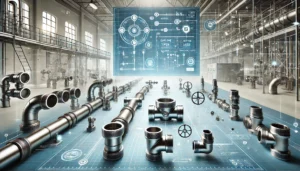Valves are essential elements of industrial systems that control the migration of fluids, gases, and slurries in many final processes. Each class of valves is specially manufactured to allow the needs of different valves in various industries to be satisfied. Whether it is to control the flow rate of a liquid or gas or to contain the pressure in adverse conditions, valves are important in ensuring that processes are optimized, the safety of equipment is enhanced, and the system able to function properly.
In this article, however, the top 10 industrial valves will be described along with their uses as well as each of their design and functionality and importance in different industries.
1. Gate Valves
Overview
The primary purpose of gate valves is to enable or disable movement of the fluids. The fluid flows through a pair of vertical sliding gates or wedges which open when turned, preventing fluid from flowing when closing.
Applications
They are widely applicable in oil and natural gas installation systems, water treatment plants, and power generation stations. They are great for switching processes that require only a small pressure drop while blocking ligating areas or controlling streams in refineries.
Key Advantage
They assist in providing pressure due to the strong seal able to withstand high pressure. A downside is that they are not to said to be used for throttling as it will wear out the sealing surfaces.
2. Globe Valves
Overview
Fluid moving thru globe valves is achieved with a dial using linear motion because globe valves are equipped with a disk. These valves are ideal for rotating applications requiring flow control.
Applications
Chemical processing assembly, power assembly and HVAC range of valves are integrated with globe valves. Such systems are used where throttling is required and steam, coolant water systems and fuel systems are examples.
Key Advantage
Due to the shape of their reseating surface it is easy for them to regulate flow and hence they are suited for applications requiring accuracy.
3. Ball Valves
Overview
A ball valve is made of a rotational ball with a drilled passage, this ball serves the purpose of controlling the fluid movement through a valve. When the flow opening is aligned with the pipeline the valve is opened but when twisted the openings are perpendicular to the inlet and closure takes place.
Applications
Ball valves are best suited for the oil and gas transmission, water and water treatment operations, chemical processes and storage. Locations which are sensitive and require flow control and overhaul ball valves are most suited.
Key Advantage
The valves are very tight sealing types and are easy in operation, they also have high and low pressure and temperature performance.
4. Butterfly Valves
Overview
Butterfly valves are used to throttle flow using a disk, placing it in a rotating manner which is inside the valve. The valves are small in size, are lightweight and are compatible with big sized pipe systems.
**Applications**
The applications for these valves in HVAC systems, food processing and water treatment industries are extraordinary. Moreover, they can also be employed in irrigation, air handling, and cooling systems which are low-pressure illustrations.
**Key Advantage**
Installation of butterfly valves is simple, inexpensive and their operation is speedy.
**5. Check Valves**
**Overview**
Check valves belong to the category of one way valves, which are used to obstruct any backward flow of water. A backward flow would trigger the flow to reverse automatically by closing the valve.
**Applications**
In most water supply networks, in the pipeline for oils and sewage lines check valves help avoid damaging pumping equipment by the reverse flow of water and messes up the whole piping system.
**Key Advantage**
Because they can be found in relatively harsher environments, they are self-functioning and require little attention when it comes to maintenance so they are reliable for sensitive areas.
**6. Pressure Relief Valves**
**Overview**
Pressure relief valves are termed as safety equipment because they release excess pressure without damaging and causing the system to fail.
**Applications**
Petrochemical industries, power plants, and pharmaceutical industries require them the most as they are able to use them in pipelines. Pressure relief valves are useful whenever there is a pressure accumulation so they can help the most in boilers, and drugs making industries.
**Key Advantage**
They become invaluable pieces of equipment as they help avoid any pressure issues by automatically releasing excess pressure during over limit.
**7. Diaphragm Valves**
**Overview**
Diaphragm valves or membranes are vales which have a membrane in the form of a flexible disc to control how much fluid passes from one point to another, making them well suited for molecular compounds which dissolve precious materials.
Applications
Diaphragm valves are widely used in food, beverage and pharmaceutical as well as chemical industries. They are applicable in areas where preservation of hygiene such as sterilized areas is needed.
Key Advantage
The portion that comes in contact with fluids is explicitly designed such that there is no contact that occurs, allowing it to be useful in sanitary purposes.
8. Pinch Valves
Overview
Pinch valves regulates the passage of a flow through a flexible tube by pinching it or around a sleeve. It is intended for products which consist of slurries, powders, and granular materials.
Applications
Industries such as mining, wastewater treatment and cement utilize pinch valves. It is amazing in dealing with mediums that are viscous and abrasive.
Key Advantage
One of the features that they possess which makes them durable even in severe conditions is their simple design as it guarantees that the equipment suffers little wear and tear.
9. Needle Valves
Overview
Needle valves makes use of needle shaped plungers in order to control the flow. They serve well for fine flow rate adjustments in particular systems operating at sub and moderately elevated pressures.
Applications
Instrumentation, laboratories, and fuel injection systems are now able to make use of needle valves. This is crucial for those systems that need precise modifications like controlling the gas flow in analytical devices.
Key Advantage
Due to their capability of controlling fine adjustments, they are vital for tasks that require a high degree of precision.
10. Solenoid Valves
Overview
Fluid flow can be regulated via solenoid valves as an electromagnetic actuator controls them. They are fast acting devices and ease use with automated applications.
Applications
The dedicated valves are getting accepted in various industries such as automation, HVAC & even into pharmaceuticals. They regulate flow in processes such as water treatment, irrigation or chemical dosing.
Key Advantage
Their incorporation or integration into control systems means that they can be operated from a distance as well as regulate the flow precisely.
Conclusion
It can be stated that Industrial valves are used in a wide range of applications and enabled efficient and stable control of liquid or gas flow rate. It is essential to know the special characteristics and functioning of valves such as gate valves, globe valves, and solenoid valves since it helps the industries in choosing the appropriate type for their applications. Cost and complexity in the valves may entail a problem however by ensuring appropriate treatment of the right valve suits industries’ purpose, processes, safety, and assurance in respect to time reliable systems.










